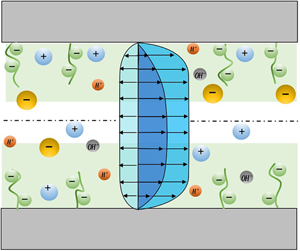Article contents
Thermo-osmotic transport in nanochannels grafted with pH-responsive polyelectrolyte brushes modelled using augmented strong stretching theory
Published online by Cambridge University Press: 28 April 2021
Abstract

In this paper, we develop a theory to establish that the thermo-osmotic (TOS) effects, induced by the application of an axial temperature gradient, lead to a massive enhancement in liquid transport in nanochannels grafted with charged polyelectrolyte (PE) brushes. We quantify the TOS transport by quantifying the induced electric field and the induced TOS flow field. The different components of the electric field, namely the ionic component, the thermal component and the osmotic component, as well as the contributions of different ions to these components, are quantified. Furthermore, we express the TOS velocity as a combination of chemiosmotic (COS), thermal and electro-osmotic (EOS) components. The COS and the thermal components augment each other and the overall strength and direction of the TOS flow are dictated by the direction and the relative strength of the EOS component. Most importantly, we compare the cases of brush-grafted nanochannels with those of the brush-free nanochannels of identical surface charge densities: the TOS transport is massively augmented in the brush-grafted nanochannels attributed to the combination of the localization of the electric double layer (EDL) (and hence any body force that depends on the EDL charge density) away from the nanochannel wall (i.e. the location of the maximum drag force) and the presence of a possible molecular slip (experienced by the liquid) along the brush surface.
JFM classification
- Type
- JFM Papers
- Information
- Copyright
- © The Author(s), 2021. Published by Cambridge University Press
References
REFERENCES
- 13
- Cited by



